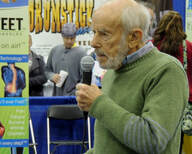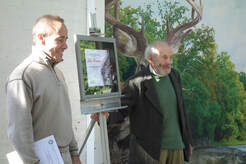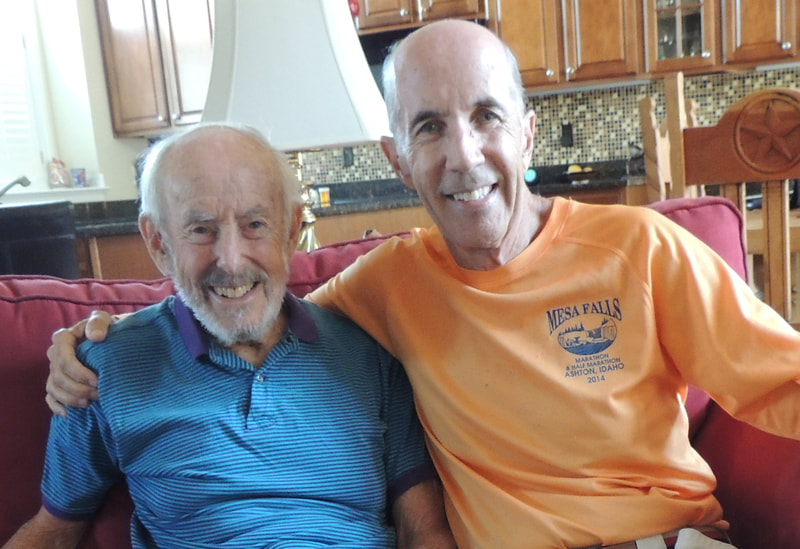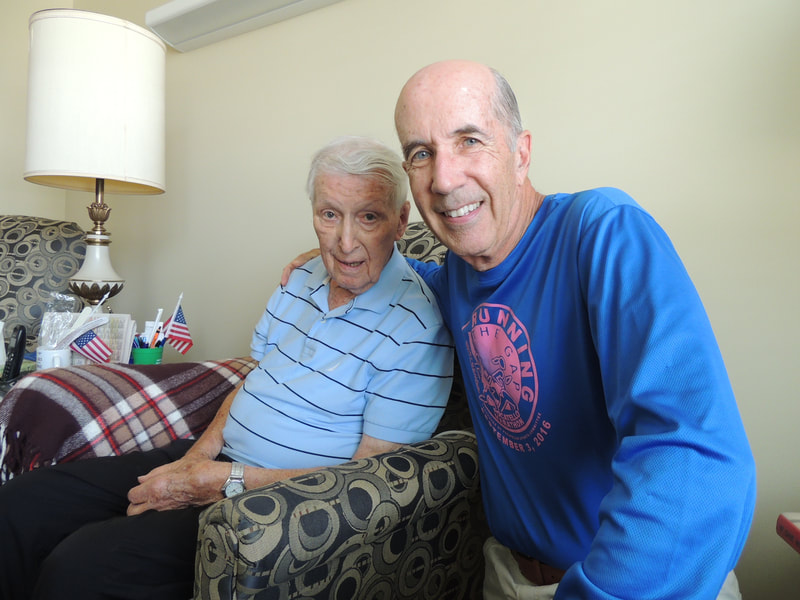Yes, he's alive and well.
|
Our favorite 100-year-old, Mike Fremont, on whose life the LifeNuts program is based, recently was featured in People Magazine - https://people.com/sports/100-year-old-runner-holds-world-records-still-lacing-up/?utm_source=join1440&utm_medium=email&utm_placement=newsletter
Yes, he's alive and well.
0 Comments
 In February, 2022, Mike turned 100. Still going strong, he continues to run at Sharon Woods park in Sharonville, a Cincinnati suburb, where we walk and chat sometimes. Recently he was featured in a podcast. If you want to hear Mike, skip to 1:24 on the time - https://www.richroll.com/podcast/longevity-masterclass-688/  All LifeNuts understand the relationship between ikigai (Japanese word for purpose in life) and life expectancy. Without the former, there’s not much of the latter. Mike, now nearly 99, which happens next Feb, told me that he was recently honored for his work in cleaning up our rivers in Ohio. He’s an adamant environmentalist. Here’s what he had to report: “On September 30, a group including Hope Taft, former Gov. Bob Taft’s wife,came to Loveland. They included ODNR Director Mary Mertz, Asst. Director Steve Gray, Scenic Rivers Manager Bob Gable, Southwest Ohio Scenic Rivers Manager Aaron Rourke and Laura Briggs, Director of Policy Initiatives. Eric Partee, Executive Director of Little Miami Conservancy hosted us. My wife and local son attended, making a max total of 10 allowed for the government for a possibly indoor meeting during the pandemic. “My (local)corrected actual river history is that OKI (Ohio-Kentucky-Indiana) had originally sought for the Little Miami’s mouth in the Ohio River to be developed as a Port Authority, a transportation hub with interstate highway, rail and river barges and related development. We sought to preserve the natural character of the river for environmental and recreational use. That entailed helping to bring to life the Ohio Scenic Rivers System in 1968, including the Little Miami as a member. I think I joined Little Miami, Inc. in 1970. “After that we founded Rivers Unlimited, the nation’s first statewide river protection system in 1972 and I was its president until 2003. In 1973 Dan Dougherty, Carl Rahe, Charlie Ball and I went to Denver, sat on the dusty floor of the Wilderness Society and founded American Rivers Conservation Council (ARCC)with 29 others from across the country). That became American Rivers soon after. I remained a director of AR for 19 years. And worked to bring the Little Miami into the new national system. The state and national status offers protection against destructive actions and for protective cleanups and plantings. And therefore adds quality of life to the value of homes in the area. We did successfully help bring national status to, ultimately, the entire river. “Respecting Mill Creek, in 1993 we sought to clean up this “most endangered river” with the Rivers Unlimited Mill Creek Restoration Project (RUMCRP) and now its water quality is much better, its flow is more normal and there’s a bikeway and scheduled kayak/canoe trips along it. It’s the Mill Creek Alliance now, in good professional hands and is an asset to some parts of its watershed, with more en route.”
In 1979 Norman Cousins, former editor and ambassador to Russia, published a book, Anatomy of an Illness, that chronicled his autoimmune disease he acquired from industrial fumes in Russia. https://www.goodreads.com/en/book/show/185256.Anatomy_of_an_Illness
At the time of his recovery in the early 1970s, he became interested in mind-body health and got involved with UCLA school of medicine, at the time the leaders in psychoneuroimmunology, the field that shows how the mind (psycho) can send chemical signals through the nerves (neuro), which can affect the immune system. Then, in 1978 Dr. Ron Glaser, a scientist trained in virology, came to Ohio State and began working in this field, a pioneer in PNI. I had read several of his studies. So, a few days ago I decided to look him up and was shocked to learn of his death last year - https://news.osu.edu/in-memoriam--ronald-glaser-phd/ His work, quintessential in PNI, though voluminous, has gone mostly unnoticed by the media. Look at his CV to see what he accomplished. In 1982 he married a psychologist, Janice Kiecolt-Glaser, and, together, they became pioneers in PNI, eventually becoming the world leaders in this field. https://wexnermedical.osu.edu/neurological-institute/researchers/janice-kiecolt-glaser-phd I felt that it was important to pass on what she is doing now with her team. If you click on her link and read about her current research, you’ll learn about mental states and weight gain and about exercise and inflammation, the culprit in many diseases. She’s also engaged in a marital study involving couples. Even though she is a psychologist, her husband’s hard science (now in the hands of other scientists on her team) has proven – biologically – the link between the mind and the immune system. Although their work has merited recognition in the scientific community, it gets little exposure in mainstream media, even though, today with the virus pandemic, it’s even more pertinent. In fact, if you ask the average guy or gal about PNI, they’ll scratch their head. Recently, during my annual physical (zero problems), I asked my physician, a smart person, about PNI. She didn’t have a clue. In our lifetimes, we won’t see PNI coming to the forefront of medicine, but it will play a major part in health … maybe 100 years from now. Yes, there are many benefits to a plant-based diet and cardiopulmonary exercise, but understanding PNI is equally important. In the LifeNuts program, I devoted an entire chapter to it, which is listed, for free viewing, on this website. In the meantime, be positive, be happy, and don’t worry (it releases cortisol) – the pandemic will end someday. While running yesterday morning it came to me – the solution to solve our country’s (and the world’s) most serious health crisis, which, as few want to admit, is obesity. The answer is exactly what the media thrive on and what can be a terrific motivator – the somber four-letter word, FEAR. The media uses fear to sell their wares – TV time, radio talk, print publications.
I’ve seen, for a long time, that obesity, that politically touchy subject, has essentially been ignored by the American Medical Association and the health insurance industry. Why? Well, since obesity leads to a myriad number of diseases, it helps keep the medical community thriving and hospitals full. And, many of these leaders, the physicians and nurses, aren’t in good shape – weight-wise or aerobic-wise. How many of them could run a mile in under ten minutes? Their medical model is two-fold: testing and treatment, both of which involve money. Prevention? No, it doesn’t pay. If you do a search for the biggest health crisis in America, you’ll get 766 million links. In 2018 the CDC did a press release - https://www.cdc.gov/media/releases/2018/p1221-2018-year-review.html, which shows American’s life expectancy declining. If you read it, you won’t find any mention of obesity. Though the release did mention the word, “preventable.” Dr. Redfield, the CDC director, does not walk the walk. I did a search on Google: does obesity affect immune system? I got over 34 million links, all explaining how obesity lowers immunity. That’s right – 34 million. Yet, no one cares. Except perhaps a small percentage of the medical community and an even smaller percentage of the population. Drs. Barnard, McDougal, and Greger seem like voices in the wilderness. I applaud them for not having given up their fight. What would happen if one of them were to take the place of Dr. Fauci or the incredibly obese Robert R. Redfield, MD, director of the CDC? The new AMA president, Dr. Harris, an African-American psychiatrist, lists goals for her term:
Does she mention the obesity crisis? No. Prevention? No. How does she feel about the incidence of obesity in black Americans, which is about 50% - with 14% being morbidly obese? What does she think about the 17% obesity incidence of Asian Americans? Hmmmm. Why are they much healthier? No, Dr. Harris and her colleagues continue to ignore this issue. If dentists followed this model, they would never have pressed for community fluoridation, which has dramatically improved the dental health of millions … and also reduced the need for more dentists. A few weeks ago four of my grandkids spent the night, giving me the chance to present a mini-stress management seminar. When I mentioned the health crisis of obesity, I asked them why we don’t talk about it. Little Lucy explained, hitting the nail on the head, “Pop, if we tell someone that they’re fat, that hurts their feelings.” How true – from the mouth of a child. In the year 2000, 30.5% of American adults were obese. That climbed to 35% a few years ago. Now, the Centers for Disease Control and Prevention reported that the obesity rate reached 42.4% in 2017-2018. I estimate that the percentage of overweight (not obese) Americans is close to 90-95%. I also predict that we’ll hit 50% in the obesity category within five years. America ranks 38th in life expectancy (was 35th only five years ago) despite spending more on health care per capita than any other developed nation. The leader? Japan. So, what’s my solution? The Fear Factor. Turn this virus thing into something positive. Blare on the news channels, in newspapers, in social media that overweight and obese people are much more likely to contract the virus … and die … than a fit person – since obesity reduces the body’s defense system. Give them examples: fat people who’ve lost weight. I, myself, was obese in 2005. I made changes, lost weight, and got my bmi to around 20 – and I’ve been able to maintain this for 15 years now. Make it easy for the average Joe and Jane to understand: be able to run a mile in under ten minutes, eat fruits and veggies, avoid saturated fats. Limit fast food. I hate the phrase, “We’re in this together,” since staying healthy is a personal choice. Single. Just me, not us. The media tells us that “we” must wait for the treatment for this virus and for a vaccine. Baloney. They should tell us to lose weight, get our bmi under 25, and increase our VO2max – in simple terms, of course. It’s our choice: lose weight, get healthy or get sick. And, this is a nasty virus, attacking the lungs, requiring a ventilator. Paint the picture gory, scary. Use fear as a weapon to reduce obesity. And stop sugar coating the word, fat. The problem is, as you know, that, as Cicero wrote, misericordia familitatem amat: misery loves company. Since most of the world is fat, being overweight is acceptable. Watch TV commercials. Thin people are almost the exception. The big ad agencies on Wall Street know what their market is. Yes, there are some who, because of disabilities, won’t be able to exercise vigorously. There are some who have genetic problems with weight. Some are mentally handicapped. However, I’ve seen thin people in wheelchairs, which makes me think that they must eat sensibly. Now, I’m no scientist, but I’m sure that others, able to use forums much more powerful than this little blog, have similar thoughts. What are they waiting for? And shame on the AMA and the CDC. Bill Gross, the mutual fund guru and well respected bond manager, coined – or perhaps made famous – the phrase, “the new normal,” which he often used in referring to the unpredictable volatility in the stock market. I think this phrase could also be used to describe America’s current health care crisis – obesity. This is a word and condition that we’re expected to ignore, even though it continues to grow, leading to high blood pressure, diabetes, heart attacks, strokes, and cancer. The medical community, for the most part, continues to ignore it, possibly because obesity leads to filling hospitals and doctors’ waiting rooms. As the late Alan Abelson, one of my favorite financial writers at Barrons, loved to quote, “The eat, drink, and health care industries are all doing well.”
Yes, he’s correct. In fact there’s now an etf that’s called The Obesity ETF (SLIM), an index full of companies designed to help this large segment of the population. Close to 95% of Americans are overweight and over a third qualify as obese. And Wall Street is paying attention: TV commercials, TV shows, and movies feature obese people. Advertisers must identify with their market. The New York Times ran a half-page article on January 19, 2020, “Where Plus-Size Brides Find the Perfect Dress.” And remember, this newspaper publishes only “news that’s fit to print.” It, also, must cater to its readers, most of whom are overweight. John Candy, the loved and funny actor, died – age 43 – heart attack. Such a shame, people figured; but predictable. Many other contemporary film stars, overweight as well, show the public that obesity is alive and well. America places them on pedestals. And, what has the medical profession done to counteract this trend? Not much. Hospitals are busier than ever. Most physicians are overweight. Their answer? Big pharma. Drugs. Or, more politely, medications. In fact, in the AARP Magazine, June-July 2019, an article has apparently solved the obesity crisis: “Can a Single Pill Keep You Healthy to 100?” RTB101 has “shown real promise,” according to the article, which, later on, emphasizes the solution “without the dieting.” Let’s face it: if pills worked, there wouldn’t be any overweight physicians. On the other hand, Dr. Neal Barnard, founder of a group of physicians who are dedicated to teaching healthy lifestyles, has written several books on a sensible way to gain health. His books on reversing diabetes – mostly revolving around a plant-based diet – have sold well. But, despite his heroic efforts, he’s a small fish in a big pond. The final decision, to change from the high-fat, high-sugar American eating style and to exercise strenuously and regularly, a prescription for health, rests with each individual and, most importantly, must come from within. Make the choice – enjoy your children and grandchildren – or follow the crowd and die young. LifeNuts know what to do.
I realize that my blogs aren’t coming often these days, but I have an excuse: I’m fully engrossed in my “ikigai,” which is doing paintings of old barns and writing essays about their stories, some of which are fascinating. My new ikigai – you understand this term if you know LifeNuts well – began in 2012 and has driven me to paint hundreds of old barns, uncover bits of Ohio history, and preserve pieces of the past before they vanish from our landscape, which happens almost daily. Arcadia Press will be publishing a book on my work, another attempt to capture history for future generations. And, though I do the LifeNuts blogs rather inconsistently, I write a barn art newsletter every month, which tracks my progress in reaching all 88 Ohio counties, something I hope to accomplish by this October. If you’d like to be included in the newsletter, send me an email through the contact form on this site.
Oil paintings and essays aside, I walked with my nutritional and longevity mentor, Mike Fremont, a few days ago and wanted to give an update on the original LifeNut, the guy who inspired this website. At ninety-seven and a half, he’s still going strong. He told me he had planned to “run” 10 miles – now his running speed isn’t up to Kenyan standards but he covers the miles – but it was awfully hot. Yesterday the heat index in Cincinnati was over 100. We walked about three miles, talked, and solved most of the world’s problems. Mike can spit out facts and figures as quickly as any 25-year-old. A Yale engineer grad, he focuses on the changes in our climate, which have evolved greatly from the Ice Age. His mind, rich in information he gleans from newspapers and the Internet, shows me that his plant-based diet and daily exercise continue to perfuse his brain cells with nutrients, allowing him to lead a purposeful life. He also likes to compete, which he did on July 28 in the Little Miami half marathon. He finished third in his age bracket – 70 and over – which doesn’t seem fair, pitting him against runners nearly 30 years younger. Here’s his time - https://runsignup.com/race/results/?raceId=46158#resultSetId-164860;perpage:10 As you can see, he narrowly missed first place by two hours and, though he wasn’t proud of his time, he finished 13.1 miles on a warm day, something that over 90 percent of Americans would not be able to do. He also got a chance to run next to the Little Miami River, a national scenic river, which, through his environmental efforts decades ago, sparkles like a Colorado stream. And, I’m sure that he inspired others during the race if they stopped to find out his age. Perhaps they asked him how a ninety-seven-year-old could still run, instead of being confined to a wheel chair or a nursing home. Regardless, I’m fortunate to have met him in 2007, learned from him, and to have changed my life. Thanks, Mike. Answer: run a half-marathon and a 10K.
Actually, our hero Mike Fremont was only 96 when he ran – or tried to run – the 2019 Daytona Beach half-marathon in early February, a race I did two years ago, which is why I mentioned it to Mike. I liked the race because it started and ended in the massive NASCAR Daytona stadium and gave us a chance to run a lap – just like the drivers, though they go a bit faster on their laps. It was out and back, with a small stretch on the beach. Unfortunately, this year – when Mike ran it – the course had changed and involved zig zagging through a maze of city streets. And, to make it worse, big winds – probably 20-30 mph, which I can verify from my training run an hour north in St. Augustine – blew directional signs down. Mike, and probably several or many other runners, got lost, missed the cut-off, and wound up running about 14 miles – for which he got zero credit. C’mon folks, if you’re a race director, you should appreciate the opportunity to showcase a 96-year-old running 13.1 miles. I don’t think they’ll see him again. Nor me. Fast forward to February 24 and the 41st annual Sunrunners 10K on Vero Beach, Florida, which was, literally, on the beach. Despite having injuries, Mike competed in the race, one he’s done for the last 20 years. As Mike told me, “Don’t think I mentioned it but 10 days before this race I stepped off a two-foot-high platform while I was carrying laundry at 9:30 in the dark and broke a rib, along with hitting a knee, elbow and head. The next day I spent six hours in an emergency hospital and it took a week for me to get out of bed each day without help.” Regardless, he ran the race and complained that “Under normal conditions my time would have been about 100 minutes or 1:40; instead it was a dismal 1:59.” So that answers the question about what do you do when you turn 97, even if you’ve just broken a rib and are hurting elsewhere. And, Mike, you’ve earned the right to complain about your time in the race. After all, you’re 97 – a LifeNut for all seasons and all the right reasons. Note: I asked Mike Fremont, whose lifestyle this website is based on, to write a guest blog, as he did several times in the summer of 2012 before setting a new world marathon record in November. I thought that, since, six years later, he’s showing no signs of slowing down – although he runs mostly shorter races – his perspective on life would be interesting. I asked him, “How does a 96-year old avoid the nursing home?” Mike felt that relativity is an important angle. Here’s his response.
Don’t be overcome with fears of nursing homes. I go to visit my contemporaries in them all the time and they all seem happy, never complaining. Years ago one of these was E.E. Keller (Eek), in his 90’s, holder of international records for long-distance running. He was seven years older than I and he kept his trophies in the trunk of his old Buick parked near his apartment. He must have run on the grounds outdoors in good weather but the staff were concerned when he ran in the residence corridors in bad weather “what if someone opened a door when he was running by”, or “what about a crash with a wheelchair coming around a corner?” We “borrowed” him for a Thanksgiving Day 10K race with promises to take care of him. He not only ran the race but won his age group and got a prize! He started off pretty fast in the race and I soon realized he didn’t want to lose sight of the person in front of him! Continuing one’s sports in old age is really fun, relative to being younger. Nobody expects anything of you (they shouldn’t!). There is – effectively - no competition. Considering the 19,743 healthy diets available today, I can still run races on the Whole Foods Plant-Based Diet, the modern name for the Vegan Diet, which was the modern name for the Macrobiotic Diet that I adopted at age 69 to deal with cancer. I’d been given three months to live if I declined an operation - so, there was a gun at my head. But I cleaned out my kitchen and stretched that three months to 27 months. The surgeon said he’d looked for metastases - seen by the diagnosticians - in 35 places, and found none. That is what the change in fuel did! No radiation, no chemotherapy, just a different diet. The WFPB has let me live outside of nursing homes for 27 years, without a headache or stomach ache and maybe two colds in those 27 years. I also lost the arthritis I had on the old standard American diet and now eat all I want absolutely without concern. WFPB is meat, egg and dairy free (no poultry, fish, seafood). It’s whole grains, legumes, vegetables, nuts, seeds and fruits. There is good company in this lifestyle - our sitemaster Dr. Bob... Socrates, and athletes like Martina Navratilova, Carl Lewis, Tony Gonzales, Mike Tyson, Scott Jurek, Harvey Lewis, Serena Williams. As elders, our athletic performance is pitiful relative to younger folks and we tend to moan about how we get slower or less competitive as we age - every year, or month even, shockingly… and predictably. But the public makes a huge fuss over our diminished bodies in our occasional presences in races, which for us is incredibly rewarding. A few cookbooks? Cooking with Rachel - Rachel Albert, Vegan Soul Kitchen - Bryant Terry, Crazy Sexy Kitchen - Carr & Sarno, The Mediterranean Vegan Kitchen – Klein, May All Be Fed - John Robbins, The Vegan Table - Patrick-Goudreau, The Natural Gourmet -Annemarie Colbin, And Vegan Planet - Robin Robertson On a closing note, here’s an interesting stat: sales of vegan food rise to $3.3 billion, with experts saying veganism has “gone mainstream.” Also, the sales of vegan milk (almond, rice, soy, hemp) are up 9% while cow milk sales have dropped 6% in just 12 months. |
AuthorDr. Bob Kroeger is the founder of LifeNuts. He's also proud to be a LifeNut. Archives
September 2022
Categories |




 RSS Feed
RSS Feed